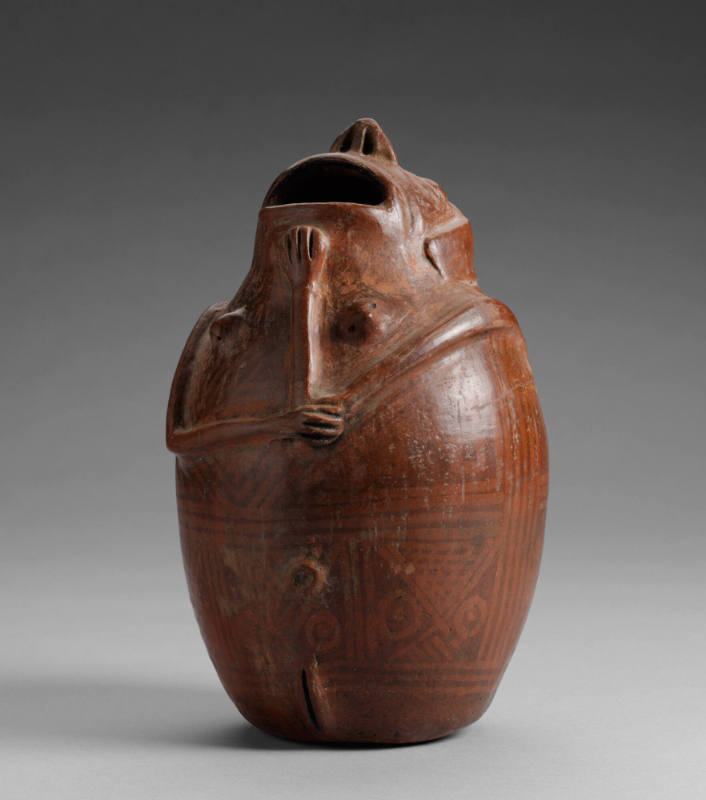

Object Details
Culture
Capuli (Ecuador)
Date
300 BC-500 AD
Medium
Earthenware
Dimensions
7 7/8 × 4 3/4 inches (20 × 12 cm)
Credit Line
Gift of Thomas Carroll, PhD 1951
Object
Number
2006.070.141
BRIEF DESCRIPTIONThis is a ceramic Capulí jar of a woman with her mouth open, as if she were singin(…)
BRIEF DESCRIPTIONThis is a ceramic Capulí jar of a woman with her mouth open, as if she were singing or shouting.WHERE WAS IT MADE?This jar was made in the mountainous region in the northern part of what is now Ecuador.HOW WAS IT MADE?This jar was made with the coil method. In this method, a base is made by shaping clay into a flat disc. Then hand formed coils of clay, like ropes, are successively added to one another, building up the walls of the bowl. A tool such as a wooden paddle is used to smooth the sides both inside and out, leaving no trace of the coils.The decorative geometrical markings on the body of the jar were done with a negative resist-painting technique. The designs you see are actually formed by the absence of decoration, rather than being a positive design as is usual with painted decoration. After a vessel is fired, a waxy, removable substance is painted on where the artist desires his pattern. The vessel is then smeared with a smudgy black organic paint, and the area with the resist is removed, leaving a lighter design showing through the darker background. Resist-painted wares often have faded (or “fugitive”) designs since the dark background color is not as durable as fired slip paints.HOW WAS IT USED?We do not know for sure how this jar was used. Except for contact-period ceramics and for some grave goods, it is very difficult to determine who used any given piece of pottery, and under what circumstances. Were some vessels reserved for special guests, or for use by high-status elders? Were they used during special religious ceremonies or rituals? Was their use avoided by certain classes of people, such as children and/or menstruating women? As we venture farther back into the past, answering such questions becomes increasingly difficult. Although it is tempting to draw on information from modern traditional societies and from contact-period chronicles, inferences drawn from such sources must be used with care.WHY DOES IT LOOK LIKE THIS?Notice how the opening of the jar is formed by the woman’s wide-open mouth. The open mouth has been interpreted, by analogy with tropical forest Indians in modern times, as a shaman singing his power song for rain or to diagnose the future or the cause of an illness. However, female shamans are usually shown seated. Notice the rounded shape of the jar and the woman’s distended navel; this might suggest that she is pregnant, in which case she could be singing about her pregnancy. Notice her realistically modeled nose at the upper tip of the jar. Although her arms are prominent, there is no indication of any legs, a common convention in such vessels from the northern Andes.ABOUT THE CAPULÍ CULTURE:The Capulí culture occupied a mountainous region located in the valleys of the rivers Chota and Carchi, between what is now northern Ecuador (Carchi Province) and southern Colombia. The people practiced maize-based agriculture, with some supplemental hunting and gathering. The political organization of this group consisted of multiple chiefdoms with small territories, with achieved rank differences and a specialist artisan class. Two types of Capulí burials are known; a deep (up to 40 meters or 130 feet) shaft tomb type, and a shallower burial tomb type under mounds or tolas. The Capulí engaged in trading coca leaves, and are famous for their small ceramic figures of men chewing coca, with prominent cheek bulges, known as “coqueros” in Spanish. Click here to see a Capulí ceramic “coquero” in the Johnson Museum’s permanent collection, search for object number 74.053.001 in the keyword search box.Capulí ceramics are typically black-on-red, decorated in the style known as negative painting, continuing an artistic tradition that appeared for the first time during Chorrera. Common ceramic vessel forms include squash or gourd-shaped bottles such as this one, annular ring-based bowls called “compoteras,” lentil-shaped plates, and globular jars.












